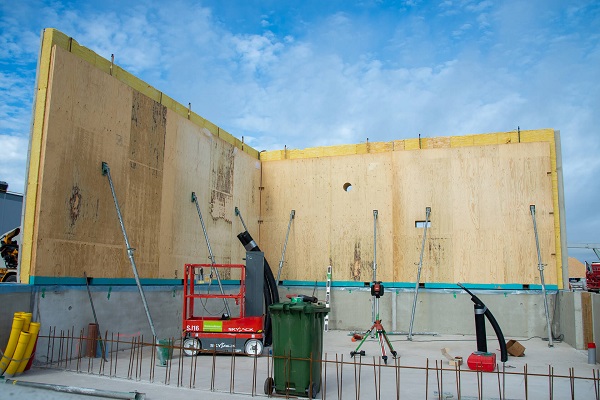New sustainable hybrid sandwich elements combine concrete and wood

Hybrid construction offers construction companies a more sustainable way of building without changing their current building methods. Metsä Wood and its partners have designed a hybrid sandwich wall element, which will renew offsite construction. The innovation combines concrete with Kerto LVL (laminated veneer lumber).
The lighter weight of the hybrid sandwich wall elements proved to be a valuable benefit in the first construction project at Metsä Fibre’s Rauma sawmill.
Skanska, the constructor of Metsä Fibre’s new Rauma sawmill, has set up an ambitious goal for itself as it aims to be carbon neutral globally by 2045. This has led the company to provide low-carbon or carbon-neutral life-time solutions to its customers: “We are happy to try new, innovative things and partnerships, and the use of these new hybrid sandwich elements in the new Rauma sawmill is a great example of this kind of cooperation. The use of hybrid elements reduces the amount of concrete, and the elements are also lighter than typical elements,” Skanska director of productivity and quality unit Ilkka Romo says.
Ilkka foresees that wood construction will increase over the next couple of years, and there is already now more demand. The forms of wood construction and their impact on business and customer wishes are under review.
“The hybrid sandwich element is a great start, and the Rauma sawmill project has provided us with useful first-hand information about their use in construction. It seems to fit well with our technical needs. Our cooperation with Metsä Wood and Metsä Fibre has started well thanks to the deep expertise of these two companies,” he says.
The production of the new hybrid sandwich wall elements, which are used in the sawmill’s log sorting building, went as planned at the precast element manufacturer Lipa-Betoni’s factory. This is the first time the factory produced hybrid wall elements.
In the production of a hybrid sandwich wall element, a Kerto LVL panel forms the load-bearing core. This is followed by an insulation layer and reinforced concrete facade.
“After overcoming the initial challenges, the production of the hybrid sandwich wall elements has been as easy as the production of concrete sandwich elements. We have succeeded in this thanks to the close cooperation with and extensive know-how of our partners,” Lipa-Betoni chief executive Satu Lipsanen says.
The installation of the hybrid sandwich wall elements for the first floor, 100 m2, of the building took five hours.
“The assembly of the hybrid sandwich wall elements has been similar to the usual concrete sandwich elements. We were able to use a lighter crane in the assembly as the hybrid sandwich wall elements are lighter than traditional sandwich elements. Their lighter weight can bring savings in a large construction project,” Skanska construction manager Petri Puputti explains.
Both kinds of elements have identical connections in the bottom, and the seams of the hybrid sandwich elements have timber screws. He also highlights that after the assembly of hybrid sandwich wall elements, the seams are finished and there is no need to do seaming, concrete grinding or cleaning, as is the case with concrete sandwich panels.
The sorting building will be ready by the end of 2021. The sawmill is planned to be ready in Q3 2022.
